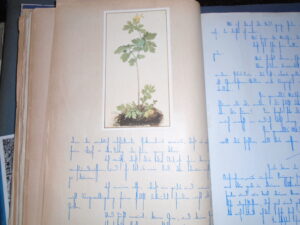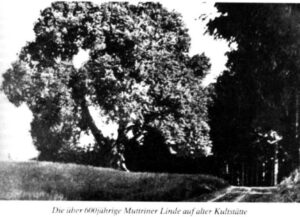I have had the great good fortune to fall in love—no, not with a person, though that has happened to me as well. I fell in love with an entire population—community gardeners all over New York City. This love emerged out of a research project about people rehabilitating abandoned buildings through sweat equity labor. As I was doing my research, I became increasingly interested in the concurrent initiatives to create community gardens in vacant lots. It inspired me to write a book about the history of community gardens in New York City, with particular attention to the 1990s.
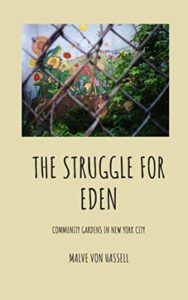
This is not the place to reiterate the complex history of the community garden movement, with some roots in the 1960s, merely to state that over the last 50+ years, 1000s of gardens have been created in various New York City neighborhoods despite a constant struggle against competing interest. Many gardens have been bulldozed, others have been preserved. The most recent positive development is the passing of a bill into law in March 2020 as a result of which many gardens currently classified as “vacant lots” will be reclassified and identified as community gardens, thus less vulnerable to being seized by developers.
There are currently over 550 community gardens on city property, over 745 school gardens, over 100 gardens in land trusts, and over 700 gardens at public housing developments throughout New York City.
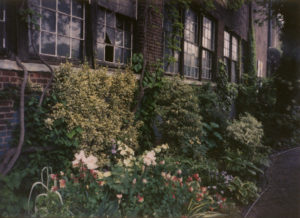 The Liz Christy Bowery Houston Garden, established in 1973, the oldest community garden in New York City
The Liz Christy Bowery Houston Garden, established in 1973, the oldest community garden in New York City
Community gardens are works in progress as is the nature of all growing things, and at the same time, they are all perched on fault lines where land trust deals or protections awarded by the city may fall apart and where a garden may be bulldozed overnight.
Gardens come in all sizes and forms—as diverse as the gardeners who create them. There are gardens filled with lost toys, sculpture gardens, gardens with beehives and koi ponds, medicinal herb gardens, children’s gardens, school gardens, gardens with theater stages, gardens that grow enough vegetables to supply not only the members of the garden but also a neighboring soup kitchen—the list goes on.
Community gardeners have dragged entire truckloads of debris out of vacant lots, laboriously carried water until waterlines could be hooked up, and lobbed balloons filled with seeds across fences. Gardeners research what to do about polluted soil, create governing structures for each garden, form city-wide associations, go to community board meetings, and get involved in the neighborhood and the city. They fight for their community and their urban environment.
I would like to highlight just a few of these gardens, in this case focusing on children.
Community gardens provide settings for community life and arenas for organization and mobilization of residents. In many gardens children are actively involved in growing food for informal neighborhood distribution, green markets, and soup kitchens and are thus exposed to experiential learning about the environment, food production and nutrition as well as social, political and economic dynamics in an urban environment. Community gardens contribute to changing conceptualizations of raising children in an urban environment and are critical to the dialectical process of the transformation of “community” along new concepts and themes.
According to the American Community Gardening Association, a key element in the definition of a community garden is that there must be different generations including children at work side by side. This ideal is by no means always realized. Nonetheless, community gardens involve a remarkable level of diversity in terms of age as well as race and ethnic backgrounds. In community gardens on the Lower East Side and in other neighborhoods in New York City, there are many projects and programs devised for and by children in and around these gardens. While the level of active involvement by children varies from garden to garden, children are granted a degree of freedom and responsibility otherwise difficult to attain in an urban environment.
In New York City there are basically four types of gardens with regard to the involvement of children.
One is the regular community garden with its haphazard mix of ages of its members. In those gardens children of different ages participate alongside their parents or play in the common area that most gardens have. Teenagers are underrepresented in these gardens. In some gardens, for instance the Green Oasis Garden on the Lower East Side, a junior board of directors, consisting of children and young adults, operates alongside the adult board of directors, with active involvement in the running of the garden and the decision making process.
The second type of community garden includes a separate area specially designed for and by children, combining a mixture of playground and planting areas against the backdrop of the garden. These gardens also place greater emphasis on special programs directed toward children from ages 6 to about 12 years, either through schools or organized by garden members, ranging from environmental education to art workshops and musical entertainment.
The third type is a garden designed specifically as a children’s garden; the age group addressed in these children’s gardens generally ranges from ages 5 to about 12.
The fourth type involves a garden, in which middle school and high school children, essentially teenagers, are principal garden members and organizers of the garden; in several instances this extends to distribution and marketing of produce grown in the garden and operation of neighborhood green markets and farm stands. In several gardens of this type, students have also been developing web pages about their gardens. The critical element is responsibility; that is, gardens most successful in attracting and maintaining long-term involvement of teenagers are those in which teenagers have a large share of the responsibility.
Analysis of community gardens and of political struggles on their behalf reveals the diversity of themes related to the benefits of community gardens to children. These themes include education, environmental awareness, notions of self-help and community organizing, creativity, self-directed learning, cooperative work, and participation in community life.
La Plaza Cultural de Armando Perez Community Garden https://laplazacultural.com/
La Plaza Cultural is located at 9th Street and Avenue C. It occupies about 1,000 square feet of growing space, farmed communally and organically. The garden contains a sculpture garden, an open grass area, a wildflower bed along the border, some vegetable plots, and a large paved plaza inside the garden in front of an amphitheater complete with a vine covered trellis on the top. The wildflower bed was the brainchild of a landscape architect living on the Lower East Side who moved to New York City in 1991. Witness to the squatter scene in that garden in the early 1990s, this man became involved in clearing debris out of one area of the garden along Avenue C. In 1995, with the assistance of a teacher from a local day care center and preschool, he started a class around the project of setting up a wildflower garden. Approximately 30 children learned about plants, seeds, the environment, and gardens and helped with the planting. For many children this was their first direct experience with plants. A few children still feel a connection to that garden and come by regularly to check on the progress of what they consider to be “their flowers”. Similar programs involving local organizations have followed. Nonetheless efforts remain fragmented and hampered by a lack of funds and labor power of committed adults.
Another project in La Plaza Cultural also was started by adult garden members in the mid-1990s. The vegetable plots are planted by children with the help of adults. Harvested food is delivered to the Trinity Lutheran Parish soup kitchen at least once a week from June through November. There is also a link to a community-supported agricultural project in New Jersey. This project seeks to link consumers in an urban community and local farmers. La Plaza gardeners are provided with farming workshops, technical assistance and materials from Rich Sisti, an organic farmer of Catalpa Ridge Farm in New Jersey. This same farm has an ongoing arrangement with the 6th Street Community Center. Part of the CSA [Community Supported Agriculture] farms network, the farm delivers produce to a food cooperative organized by the Community Center. Members in the cooperative receive fresh produce on a weekly basis. Children involved in the food production project at La Plaza and others from the Lower East Side have been visiting the farm as part of their summer day-camp experience; for several weeks they help to plant and harvest.
East Side Outside Community Garden
http://www.reclaimedorganics.org/garden
At 12th Street and 1st Avenue there is a garden associated with a high school. This garden, founded in 1983, is the product of labor by children in the neighborhood. With a minimum of adult guidance, the garden was designed, constructed, and planted by and for children. Teenagers are in charge of the organization and planning for the garden and also run the organization Open Road of NYC, Inc., which supports similar projects for young people in the city. With some support from the school and the Trust for Public Land, teenagers began working in various neighborhood gardens as volunteers in 1991 in order to learn about the work involved. The garden was formally started in 1993. Some of the children have been involved since the garden’s inception. In the fall of 1998, some of the original members, who had been involved in designing the space, graduated and went on to college, retaining a close connection to the garden and their friends. New member candidates are interviewed by their peers. The current crew of 13 children includes high school and middle school children. The children come to the garden almost every day after school. The children also are involved in extensive writing projects; they write about their experiences in the garden and beyond and produce a newsletter about the garden, its history, and its current and future projects.
Awareness of the precarious nature of the environment as well as community initiatives is inescapable for the young people involved in the project, confronted daily with a sign at the entrance that proclaims the garden site used to be a bus depot and that the ground had been heavily contaminated with fuel. This project reflects the ambitious and innovative use made of the site. The entire garden with its pond, a greenhouse, organic vegetable and flower beds, and compost and worm bins was built on top of a liner to protect against the contaminated soil.
Children’s Mural Garden
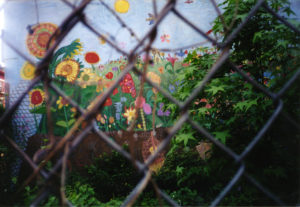
The Children’s Mural Garden at 12th Street and Avenue B is located in a small 20 x 60′ corner lot, originally occupied by a tenement building. It borders on a public playground that has been restored as result of neighborhood activism. Created specifically for children and designed by children, the Mural Garden contains a gazebo, a vegetable area, a flower area, and a little waterfall. A solar panel powers the pump underneath the waterfall; as lovely illustration of its operational principle, the water flow stops in the afternoon when the panel is in the shade. Children were involved in the work of designing the actual garden; they were presented with problems and invited to work out solutions. For instance, children designed the storage space underneath the gazebo floor.
The garden is dominated by a mural along the entire back wall, with a river painted down its center so that it seems to merge into the waterfall. Several adults started the Mural Garden project in response to the fact that community gardens are not always welcoming to children.
About 150 children were involved in the mural project, with a core group of about 40. Most of these were under 10 years old. The actual work process–preparation of colored drawings on paper, wall priming, transferring outlines of the drawings onto the wall, and applying paint, together with the challenges of working on a scaffold, through cold spells and rainy days, with paint dripping down and the need for speed–is reminiscent of the trials and tribulations of Michelangelo in the Sistine Chapel. It took two years till completion in October 1996, with various groups working on various schedules, during schooldays, on weekends, and in the evenings.
The overall themes were developed by the adults; the mural shows the underworld, the water world, the sky, the plant world, the vegetable world, and the flower world. Within these themes children contributed freely and creatively. One child drew a flower with a purple dot above and explained that this was the flower releasing its smell. One girl appears in the mural, swimming in the river that bisects the mural and flows into the little rock garden and solar powered waterfall. One child drew seeds with plants growing inside; the symbol on the leaflet for the opening ceremony is a tree inside a seed. Another girl drew a plant she had seen growing in a garden. Nobody knew what it was until an herbalist happened to identify it from the drawing, which was detailed enough for such identification. It turned out to be a plant of the amaranth genus, which was used by Aztecs for grain and has the highest protein content of all the grain plants. Eradicated when Cortez came to Mexico, some efforts are now made to grow this plant again. Sadly this girl herself never knew what she drew; she is one of many children who have disappeared since the formal ribbon cutting in 1996.
Through community gardens children become increasingly aware of the many factors–social, political, economic, and environmental–affecting lives in urban environments. Their experiences are transformed into concrete action in community gardens which also increasingly extends to other factors at a wider social, political, and economic level. For instance, the lesson of constructive mutual dependency as part of a productive relationship between local gardeners and regional farmers is reinforced again and again. Local farmers donate hundreds of pumpkins to the 9th and Avenue C Garden on the Lower East Side for fall harvest celebrations and pumpkin smashes. Children are thrilled by these events. At the same time such events provide a context for experiential learning about gardening, sharing, and even recycling and composting.
The impact of community gardening initiatives on children is not easily quantifiable or measurable. In direct reflection of an extremely fragmented social-economic environment, many children involved in community garden projects come from troubled homes and families struggling with unemployment, homelessness, poverty, and attendant consequences. Thus, stories of disappearing children abound, and organizers of projects often are overwhelmed with the difficulty of keeping track, not to mention actively assisting children beyond the limits of the particular project. One of the gardens bulldozed in December 1997 was involved in a tutoring program for children from a neighboring shelter. Now the impact of that effort appears impossible to measure, if it has not completely evaporated in the meantime. The garden on 12th Street, run by local teenagers, is an exception, in terms of its longevity, the length of individual children’s involvement, and the amount of follow-up.
Some community gardens, in their struggle to stave off the bulldozers make claims about their community programs and children’s programs in particular that appear overblown. It is reminiscent of the crazed effort on part of many New York City parents to present their children as extraordinary in order to obtain a coveted place for them in elementary school. To be ‛just’ a child among other children is not enough for survival in today’s competitive world. By the same token, a garden that is just that, a garden, much loved by its members, in itself hardly in need of justification, has far less chances to survive in the political game of high stakes, power, and public relations than a garden that can offer a range of brilliant and unique programs for adults and children. Nonetheless many programs are impressive and memorable such as the 12th Street Garden or the Children’s Mural Garden, to name just a few. Whatever the impact, it is hard to resist the compelling image of children creating art, planting vegetables, designing a garden, or going on a day-trip to visit friends from their garden who have gone on to college. The assumed or envisioned impact of community gardening initiatives on children is a cornerstone in the ideological conceptualization of the role of these gardens in the community. Involvement of children provides a means to concretely illustrate that this struggle is not over a few semi-private backyards for extended family barbecues or the horticultural hobby of a few individuals, but rather about the way of life of an entire community.
I am beyond grateful to have been able to witness some of this labor of love, tasting the jam made of peach trees on the Lower East Side, drinking juice from elderberries in a garden in Harlem, and eating home-grown potatoes at a feast in a garden on the Upper West Side, and honored to talk to the gardeners, to the ones who have done the hard work and continue to do so even when faced with bitter disappointment such as witnessing the bulldozing of their garden.
Community gardens are seedbeds of hope for the future of our urban environments. Created in vacant lots strewn with debris, these gardens provide settings for lived democracy—endlessly diverse, messy as gardens are, riddled with conflict, at times chaotic, they create dreams within a dream of what our world could be.


